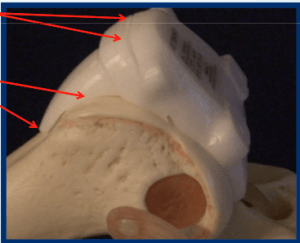ShapeMatch Knee Replacement Technology Leads to Less Pain, Quicker Recovery for Patients
Originally published May 21, 2012 from FloridaMD
Knee replacement surgery is an effective treatment for degenerative conditions. Osteoarthritis, rheumatoid arthritis, posttraumatic arthritis, and avascular necrosis are all examples of conditions that can be severe enough to necessitate full or partial joint replacement surgery. Recently, exciting technological advancements have allowed doctors to improve implant positioning which can ultimately improve patient satisfaction and implant longevity. This is called Custom Fit knee replacement surgery using ShapeMatch technology.
Knee Surgery Prior to ShapeMatch Technology
After a careful exposure of the joint, the surgeon machines the end of the femur (thigh bone) and the tibia (shin bone). This is done by placing cut blocks on the bone during surgery. The cut blocks contain slots and a saw blade is placed within the slots which shapes the bone allowing the bone to accept the prosthetic implant. The cut blocks are then removed. Surrounding skin, ligaments and tendons are carefully preserved during surgery. The freshly machined bone and implant fit together like a puzzle with the worn cartilage removed during this process. The implants,which are typically made out of cobalt chromium (steel), titanium,and ceramic coated alloys (oxinium) are bonded to the bone using either cement or cementless techniques. A polyethylene (plastic)insert is snapped into the joint.This provides a smooth low friction surface between the metal components.

Figure 1: Screen grab of ShapeMatch pre-op surgical plan. Both MRi and CT (Computed Tomography) scans can be used for these protocols.
We have known for decades that implant alignment has a huge impact on clinical outcomes. If the components are cemented improperly, load transfer will be uneven. If the artificial joint surface is not loaded evenly, certain areas within the joint will see undo stress which can lead to early mechanical wear. Wear of the polyethylene ultimately leads to implant failure and revision surgery. In addition to mechanical wear, suboptimal implant position or sizing causes inappropriate tension on soft tissue structures. This can lead to pain, stiffness and instability. Take the medial collateral ligament (MCL) for example.If the implants are not appropriately aligned (“crooked”),than the MCL may be over tensioned which can stimulate nerve fibers that transmit pain impulses to the brain.
Placement of the cut blocks is a key part of the surgery. The traditional method of aligning the cut blocks is mechanical jig navigation. For the femoral component,an alignment rod is placed within the femoral shaft. The cut block is attached to the alignment rod. Then, the cut block is pinned into place on the femur. Stated differently, the cut block is positioned based on using the alignment rod as a frame of reference. The tibia is handled in a similar manner.
Computer navigation (Robotic Arm)was a major technique designed to aid in implant position. The surgeon utilizes a tracking device to collect anatomic data points which are transmitted wirelessly to the computer during surgery.A computerized image is formed that gives the surgeon information on where to place the cut blocks. Using the femoral component as an example,the computer takes the place of the intramedullary alignment rod.
One potential downside is the use of the computer system itself. Feeding the anatomic data into the system is generally a streamlined set of tasks, but it does add time to the surgical procedure. Another constraint is the added cost of the computer system.
ShapeMatch Surgery Differences

Figure 2a. Frontal view of Custom ShapeMatch guide applied to the femur. Partial (uni-compartmental) cutting guides are also available.
The traditional method is time tested and often yields good to excellent results.However, it typically is considered a “one size fits all” solution to implant alignment.Each knee has subtle anatomic difference,therefore it seems natural to use customization techniques during implantation.
Custom Fit ShapeMatch technology is a major breakthrough because it creates individual cut blocks based on data obtained prior to the surgery. No surgical steps are added and the use of intra-operative computers are not required. All of the necessary anatomic data is gathered by obtaining a special pre-operative MRI.Through secure channels, the MRI scans are sent to the implant manufacturer. The images are used to create cutting blocks that are individualized for each person’s knee utilizing 3D imaging software.

Figure 2b. Side view of custom ShapeMatch guide.
Two weeks prior to surgery, the surgeon actually logs on and reviews images online that show the patients MRI pictures, the planned bony cuts and how the implant looks in relation to host bone (Figure 1). After approval, the company makes the cutting blocks and ships them to the medical center in plenty of time for the surgery (Figure 2a and 2b).
Potential benefits of custom knee replacement surgery include a more natural feeling knee joint, improved stability, shorter operating time, quicker recovery time and faster return to desired activities including sports such as golf, hiking, cycling, horseback riding, water skiing and others. Most importantly, this technique is easily applied to modern minimally invasive knee replacement techniques. All major brands including Stryker™, Depuy™, Smithand Nephew™, and Biomet™ currently have FDA approved custom knee replacement options available.
ShapeMatch Custom Fit knee replacement surgery has fit nicely into my current minimally invasive knee replacement surgical practice. The versatility of these techniques plays a valuable roll in serving an active high demand patient population.For example, customization can be applied to both fixed and rotating platform implants and for both full and partial knee replacement styles.



